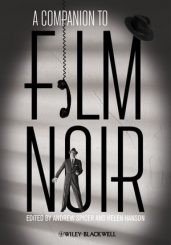This edition of mostly recent texts on the style, genre and aesthetics of film noir covers a huge variety of themes such as technical details and production modes, elaborates on the roots of many noir films in American (hard boiled) detective fiction and pulp stories, and expands into the survey of the many “victims,” so to speak, the style has left behind: cinephiles, collectors, movie directors, the style and ambiance of other media and the birth of film studies itself.
Actually, it is astonishing that some 500+ pages should suffice to cover the essentials of the genre in short essays, which may not be the ultimate writing on their respective topics, but amalgamate traditional and recent scholarship.
However, here it works, owing much of the book’s quality to the brevity of the texts (about 15 pages each) and to its authors, mostly professors of film studies, cultural history and other disciplines connected with American cinema, sociology and popular culture.
The list of contributors is good enough to make at least two contemporary all-star teams any film department in the world could only dream of, including Robert Porfirio, Yvonne Tasker and William Marling.
The study of American painting and photography as related to film noir camera shots by Tom Ryall struck me as one of the many highlights of the volume. The section of “Noir in Other Forms,” or in this case, other media variations of the noir tradition, namely radio, comics and TV is very interesting, too. Here, Jesse Schlotterbeck’s “Radio Noir in the USA” stands out.
So the 29 essays assembled cover about every aspect of noir as genre, style, medial approach, language, gender roles and location; that is, they do so far. (This is one reason why, in my opinion, it is always worth waiting for new publications on the topic, since, for example, 15 years ago there were no academic texts on the influence of noir style on comics; even though in the last decades there have been some comic artists at work employing nothing but black ink).
While, fortunately, over the last five years or so a large number of books on film noir have been published (a few are reviewed here), not all of these approach the style and the genre with such critical vigor as it is found here. And among the authors, there are some new and young experts, who hopefully will publish more on the subject.
If there is a general approach present in the majority of the texts it is the “… emphasis on the internationalism of film noir” that “… is part if the revisionist impulse that drives this collection. It challenges a major strand of the construction of film noir that defined it as an exclusively American phenomenon,” writes editor Andrew Spicer.
For that matter, the book is good film noir criticism than mere film description and praise. Perhaps one would wish for more than the 29 film stills, but then this edition is devoted to text and theory. And the Companion to Film Noir is not an introduction for the beginner but has the air of a heavy anthology (due not only to the heavy paper used here) for the expert and movie buff.
Review by Dr. A. Ebert (c) 2014
Andrew Spicer and Helen Hanson, eds. A Companion to Film Noir. Wiley-Blackwell, 2013, 542 p.
